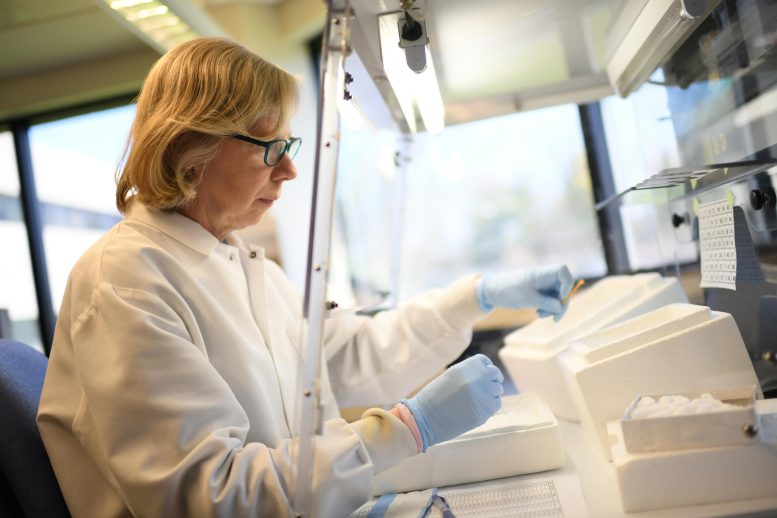- MoTrPAC examined the molecular effects of exercise on 2,600 volunteers, incorporating factors like age, race, and gender diversity.
- Building upon research in rats, MoTrPAC discovered over 35,000 biological molecules responding to endurance exercise and widespread gender differences in responses.
- Initial findings from MoTrPAC underscore the importance of including both sexes in exercise research to fully understand its health implications, advocating for diverse representation in future studies.
- By tracking exercise's impact on biological molecules, MoTrPAC aims to develop personalized exercise regimens, offering tailored approaches to treat or prevent various health conditions.
Scientists Decode Exercise's Molecular Impact
For the past eight years, researchers have been conducting a groundbreaking study supported by the National Institutes of Health (NIH) Common Fund: The Molecular Transducers of Physical Activity Consortium (MoTrPAC). With nearly 2,600 volunteers, the study aims to examine the molecular effects of exercise on healthy adults and children, considering factors like age, race, and gender. The goal is to create comprehensive molecular maps of these changes and uncover why physical activity has significant health benefits.
"This is an unprecedented large-scale effort to begin to explore—in extreme detail—the biochemical, physiological, and clinical impact of exercise," said Russell Tracy, PhD., a University of Vermont Distinguished Professor of Pathology and Laboratory Science. "I'm pleased and honored that our lab at UVM was chosen to be the MoTrPAC Biorepository, and anticipate that the MoTrPAC 'maps,' when coupled with the carefully collected biosamples, will prove enormously useful over the next decade or more of related studies."
Preliminary Research Findings
In a series of papers published today (May 1) in Nature, MoTrPAC researchers laid out their preliminary findings. Scientists discovered unique molecular responses to endurance exercise in different tissues, with mitochondria exhibiting varied changes across the body. Notably, adrenal glands showed significant alterations in nearly half of mitochondria-associated genes following endurance training, a previously unexplored aspect.
Gender differences were observed in molecular responses across various tissues, particularly in white fat tissue, suggesting implications for personalized exercise recommendations, especially in conditions like obesity.
These findings underscore the importance of including both sexes in exercise research to comprehensively understand its health effects.
Research Technician Sandra May checks new samples into the UVM Laboratory for Clinical Biochemistry Research, a key site for the pioneering eight-year MoTrPAC study. Credit: University of Vermont
Funding and Methodology
Twenty-two grants—totaling approximately $226 million in Common Fund support—have bolstered the work of researchers across the country—including Tracy and Jessica Rooney, M.P.H., and other members of the Larner College of Medicine team at the University of Vermont. The study involves various exercise regimens and collects biospecimens before, during, and after exercise.
Recipients of the grant worked as a consortium to develop plans for recruitment into the clinical trial portion of MoTrPAC, identification of methods to analyze tissue samples, and selection of animal models to best replicate human studies. Animal models allowed researchers to search for changes in tissues not easily accessible in human patients, such as the brain, lungs, and kidneys.
Lessons learned from initial phases in animals were then used to optimize protocols for full-scale recruitment. The ultimate aim is to personalize exercise recommendations based on individual needs and traits, potentially leading to significant advancements in health and treatment approaches.
Consortium Network and Management
The MoTrPAC network is a robust one—The Consortium Coordinating Center (CCC), comprising the Administrative Coordinating Core (ACC), Biospecimens Repository Core (BRC), Exercise Intervention Core (EIC), and Data Management, Analysis, and Quality Control (DMAQC) Core, provide essential support to the dozens of teams involved in this project. Led by four principal investigators, the CCC collaborates with Clinical Sites, Preclinical Animal Study Sites, Bioinformatics Center, Chemical Analysis Sites, and various committees.
The CCC employs strategies for integration, safety monitoring, and effective communication. Wake Forest University School of Medicine serves as the hub, with the DMAQC Core managing many of the project's aspects. The CCC emphasizes rigorous research practices, real-time tracking, and extensive experience in coordinating large clinical trials. Its goals include fostering team science, ensuring research transparency, managing biological samples, coordinating preclinical studies, resource sharing, publishing results, and implementing analytical best practices.
Leadership and Future Prospects
Tracy is a key figure in MoTrPAC as one of the 4 principal investigators of the CCC, which secured $10 million in support. His specific role involves vice-chairing the MoTrPAC Steering Committee (SC) and leading the Biospecimens Repository Core (BRC). This core is responsible for collecting, storing, and managing biological samples from participants and animals involved in the study all of which must be done under cryopreservation conditions.
The biospecimens, which include blood, fat, and muscle tissues in humans, are crucial for the molecular analyses that aim to understand the changes occurring in the body due to exercise. His group then distributed these biological specimens to the MoTrPAC investigators, as well as other investigators who wish to conduct studies related to this large-scale exploration of the effects of exercise. Tracy's leadership in the BRC indicates his crucial role in designing and implementing the protocols for biospecimen collection and ensuring the quality and integrity of these samples throughout the study.
With additional findings from the MoTrPAC study being released throughout the coming year, Tracy and his colleagues are poised to reshape our understanding of exercise's molecular basis and impact on human health.
Reference: "Temporal dynamics of the multi-omic response to endurance exercise training" 1 May 2024, Nature.
DOI: 10.1038/s41586-023-06877-w
News
Does being infected or vaccinated first influence COVID-19 immunity?
A new study analyzing the immune response to COVID-19 in a Catalan cohort of health workers sheds light on an important question: does it matter whether a person was first infected or first vaccinated? [...]
We May Never Know if AI Is Conscious, Says Cambridge Philosopher
As claims about conscious AI grow louder, a Cambridge philosopher argues that we lack the evidence to know whether machines can truly be conscious, let alone morally significant. A philosopher at the University of [...]
AI Helped Scientists Stop a Virus With One Tiny Change
Using AI, researchers identified one tiny molecular interaction that viruses need to infect cells. Disrupting it stopped the virus before infection could begin. Washington State University scientists have uncovered a method to interfere with a key [...]
Deadly Hospital Fungus May Finally Have a Weakness
A deadly, drug-resistant hospital fungus may finally have a weakness—and scientists think they’ve found it. Researchers have identified a genetic process that could open the door to new treatments for a dangerous fungal infection [...]
Fever-Proof Bird Flu Variant Could Fuel the Next Pandemic
Bird flu viruses present a significant risk to humans because they can continue replicating at temperatures higher than a typical fever. Fever is one of the body’s main tools for slowing or stopping viral [...]
What could the future of nanoscience look like?
Society has a lot to thank for nanoscience. From improved health monitoring to reducing the size of electronics, scientists’ ability to delve deeper and better understand chemistry at the nanoscale has opened up numerous [...]
Scientists Melt Cancer’s Hidden “Power Hubs” and Stop Tumor Growth
Researchers discovered that in a rare kidney cancer, RNA builds droplet-like hubs that act as growth control centers inside tumor cells. By engineering a molecular switch to dissolve these hubs, they were able to halt cancer [...]
Platelet-inspired nanoparticles could improve treatment of inflammatory diseases
Scientists have developed platelet-inspired nanoparticles that deliver anti-inflammatory drugs directly to brain-computer interface implants, doubling their effectiveness. Scientists have found a way to improve the performance of brain-computer interface (BCI) electrodes by delivering anti-inflammatory drugs directly [...]
After 150 years, a new chapter in cancer therapy is finally beginning
For decades, researchers have been looking for ways to destroy cancer cells in a targeted manner without further weakening the body. But for many patients whose immune system is severely impaired by chemotherapy or radiation, [...]
Older chemical libraries show promise for fighting resistant strains of COVID-19 virus
SARS‑CoV‑2, the virus that causes COVID-19, continues to mutate, with some newer strains becoming less responsive to current antiviral treatments like Paxlovid. Now, University of California San Diego scientists and an international team of [...]
Lower doses of immunotherapy for skin cancer give better results, study suggests
According to a new study, lower doses of approved immunotherapy for malignant melanoma can give better results against tumors, while reducing side effects. This is reported by researchers at Karolinska Institutet in the Journal of the National [...]
Researchers highlight five pathways through which microplastics can harm the brain
Microplastics could be fueling neurodegenerative diseases like Alzheimer's and Parkinson's, with a new study highlighting five ways microplastics can trigger inflammation and damage in the brain. More than 57 million people live with dementia, [...]
Tiny Metal Nanodots Obliterate Cancer Cells While Largely Sparing Healthy Tissue
Scientists have developed tiny metal-oxide particles that push cancer cells past their stress limits while sparing healthy tissue. An international team led by RMIT University has developed tiny particles called nanodots, crafted from a metallic compound, [...]
Gold Nanoclusters Could Supercharge Quantum Computers
Researchers found that gold “super atoms” can behave like the atoms in top-tier quantum systems—only far easier to scale. These tiny clusters can be customized at the molecular level, offering a powerful, tunable foundation [...]
A single shot of HPV vaccine may be enough to fight cervical cancer, study finds
WASHINGTON -- A single HPV vaccination appears just as effective as two doses at preventing the viral infection that causes cervical cancer, researchers reported Wednesday. HPV, or human papillomavirus, is very common and spread [...]
New technique overcomes technological barrier in 3D brain imaging
Scientists at the Swiss Light Source SLS have succeeded in mapping a piece of brain tissue in 3D at unprecedented resolution using X-rays, non-destructively. The breakthrough overcomes a long-standing technological barrier that had limited [...]






















